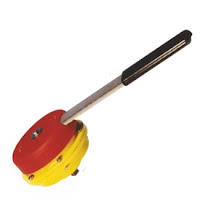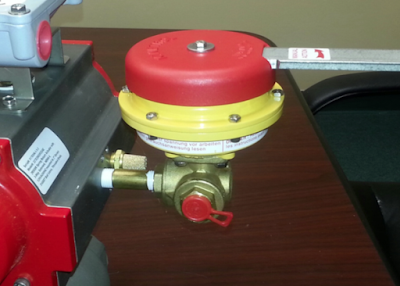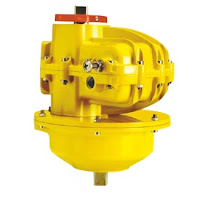A hydraulic gear pump immersed in its own reservoir delivers pressurized oil to the vane-type 90° actuator via the control box, which contains non-return valves and solenoid valves to direct the flow into the actuator; with cam operated limit switches to control travel and (optionally) signal position to the user. The unpressurized side of the actuator is connected to the reservoir, so there is no net transfer of oil from reservoir to actuator. The pump and its motor run entirely on precision ball bearings, so that the friction and motor size can be minimized and life maximized; the efficiency resulting from this reduces the heating effect and allows 100% rating. A pressure release valve is built into the pump so that if the actuator load becomes jammed the torque is limited and dangerous over pressures or motor stalls are avoided.
Fail-safe spring return action uses a reliable low-stress-range sealed clock-type spring unit mounted coaxially with the actuator, together with a fail-open solenoid valve, to ensure reliable positioning when power is not supplied to the unit. A high flow external dump valve can be fitted to allow very rapid spring-driven action.
Double-acting models are supplied with solenoids arranged to give position locking when power is disconnected. An optional manual by- pass valve is available to allow manual override movement of a double acting when power is disconnected.
The interface between pump/reservoir unit and the control box allows mounting of the pump in different orientations at 90° to each other, so that the motor can be kept above the reservoir whether the actuator output axis is horizontal or vertical. External electrical connections are all made via a single accessible connector block in the control box, with the simplest possible switching needed to drive the unit. Two conduit entries are available, to allow easy separate connection of power and signal lines (if used). All internal wiring is connected via a central connector and fuse board, and the actuator is protected from supply surges by a metal oxide varistor suppressor.
For more information contact:
Kinetrol USA
www.kinetrolusa.com
972-447-9443
The Kinetrol rotary vane design is based upon a single moving part which eliminates additional parts required to convert linear motion to rotary motion. This simple and innovative design provides a highly accurate and extremely reliable actuator for operating valves, drives and dampers, and is perfectly suited for the most demanding process control applications. For more information visit www.kinetrolusa.com or call 972-447-9443.
Showing posts with label valve. Show all posts
Showing posts with label valve. Show all posts
Valve Automation Package for Tough Hog Fuel Boiler Applications
 |
| Hog fuel boiler actuator. |
The ash from burning wood and wood wastes has a very high pH, high enough to make the wood ash exhibit a corrosive characteristic, which must be considered when selecting valves and actuators. All equipment in contact, or in close proximity, to this ash must stand up to the wet, corrosive, and dirty environment.
To facilitate the removal and transport of the ash, water is introduced for handling and management, thus creating corrosive slurries. Control valves with pneumatic actuators are used to control water flow and slurry flow. The environment is extremely dirty, and as mentioned above, corrosive. Any equipment connected to this process must be designed with performance and maintenance in mind.
Kinetrol rotary vane actuators, spring return units, and EL positioners are ideal for this type of service. Standard design features such as epoxy enamel finishes, stainless steel screws, sealed housings, and direct mount configurations provide an automation package that is proven to outlast other types of actuators and assemblies in very challenging environments.
Does Your Valve or Damper Need More Than 90 Degrees Rotation?
 |
| 180 degree actuator |
Factory fitted, direct mount linkage units are available to suit model 02, 03, 05, 07, 09, 12, 14 and 16 actuators, giving a neat single unit with no mount kits or brackets. The linkage’s unique geometry gives constant 2:1 step-up so that the output torque remains constant throughout the actuator's travel.
The all-steel mechanism of the linkage employs rolling contacts to minimise frictional losses and wear, and to maximise life. The linkage is lubricated for life, and encased in a robust, fully sealed die cast alloy casing. Exterior surfaces are protected by a corrosion resistant epoxy stove enamel finish. Standard adjustable endstops on the 90 degree actuator can be used to set the angle of travel. The other end of the 90 degree actuator allows the full range of Kinetrol modular accessories to be fitted directly.
- Simple compact unit - No external moving parts
- Unique linkage design - converts to 180° travel 120° option available
- Constant gear-up ratio through travel range - Hence constant output torque
- Rolling contact linkage mechanism - Ensures low wear, long life, low friction
- Linkage sealed for life - Protected from the environment, long maintenance free life
- Compatible with all Kinetrol modules - Direct mounted spring returns, limit switch boxes, positioners etc.
- Adjustable endstops
Tough Actuator Service on Paper Plant Green Liquor Line
 |
| Pulp and Paper Plant |
For example, the "kraft process" (also known as the sulfate process) is the method to convert wood chips into pulp and then to cellulose fibers. This is done by mixing the wood chips with sodium hydroxide and sodium sulphate, soaking, cooking and processing.
Here's a very basic explanation of the kraft process. Wood chips are soaked and processed in sodium hydroxide and sodium sulphate mixture known as "white liquor". After the wood chips are impregnated with white liquor, they are then cooked in digesters to break the wood down into cellulose. The solid pulp is then separated and the remaining fluid is referred to as "black liquor". Black liquor is further processed to remove solids and chemicals which are to be re-used in the pulping process. One of the final by-products is "green liquor" which contains sodium carbonate and sodium sulfide and is then reacted with lime to regenerate more white liquor.
All of these steps expose process equipment, piping, and valves to very tough environments. Kinetrol actuators are preferred in these situations because they don't allow corrosive atmospheres to penetrate the actuator or springs, their long cycle life, and their epoxy stove enamel finish.
Below is a picture of a Kinetrol model 14 double acting actuator on a 8” full-port ball valve on a green liquor line. The valve cycles 2 times per day to direct green liquor flow and weak wash (weak white liquor) alternatively from one pipe to another in order to prevent solids build up in the pipelines.
 |
| Kinetrol Model 14 in Green Liquor Line |
Labels:
green liquor,
paper,
pneumatic actuators,
pulp,
valve,
valve automation
Segment Ball Control Valve with Vane Actuator, Pneumatic Positioner, and I/P Transmitter
 |
| Actuator and Positioner |
In most cases standard ball, plug, or butterfly valves are not the best choice as control valves (where the process media has to be modulated or throttled). Standard ball, plug and butterfly valves usually introduce very non-linear, dynamic flow coefficients. Furthermore, they can introduce undesirable turbulence to your piping system.
As a means to linearize flow coefficients and reduce turbulent flow, the machining, or characterization, of the valve disk is done so that the machined shape allows for more optimized flow.
For ball valves in particular, machining the ball's flow port with a "V", or even by machining the ball more radically, can deliver excellent flow curves. A term for a more radically machined ball is the "segment ball" (sometimes called "segmented"). In the following video you can see how a Kinetrol pneumatic actuator, postioner, and I/P transmitter team up with a segment ball valve foe an excellent control valve.
Labels:
actuation,
automation,
ball,
butterfly,
control valve,
Kinetrol,
plug,
segment,
V port,
valve
Innovative Approach to Add Manual Failsafe Handles for Large Quarter-Turn Valves
 |
| Kinetrol manual failsafe unit |
Here's an innovate and effective way to incorporate a manual failsafe unit on large size ball, butterfly, or plug valves.
Retrofit your large valve with a 3-way "L" port ball valve and a manual failsafe spring handle on the large valve actuator's inlet air supply port.
This allows the opening of the valve with the manual failsafe handle. When the handle is released, the valve shuts automatically by venting the air to atmosphere, and allowing the springs in the actuator to close the valve.
Size limitations on the valves are no longer an issue, and this will work on anyone's pneumatic spring return actuator (spring return required, will not work on double acting actuators).
 |
| Manual Override for Larger Valves |
Pneumatic Actuator with 180 Degree Rotation for Your Multi-Port Valve
 |
| 180 degree actuator for multi-port valves. |
So you need a pneumatic actuator with more than 90 degrees of rotation - most likely for a multi-port valve, or a custom louver or damper. Here's an excellent solution.
Kinetrol vane actuators provide factory fitted, direct mount linkage units for their models 02, 03, 05, 07, 09, 12, 14 and 16 actuators, giving a neat single unit with no mount kits or brackets. An added benefit is the linkage’s unique geometry gives constant 2:1 step-up, so that the output torque remains constant throughout the actuator's travel.
The all-steel mechanism of the linkage employs rolling contacts to minimize frictional losses and wear, and to maximize life. The linkage is lubricated for life, and encased in a robust, fully sealed die cast alloy casing. Exterior surfaces are protected by a corrosion resistant epoxy stove enamel finish.
The all-steel mechanism of the linkage employs rolling contacts to minimize frictional losses and wear, and to maximize life. The linkage is lubricated for life, and encased in a robust, fully sealed die cast alloy casing. Exterior surfaces are protected by a corrosion resistant epoxy stove enamel finish.
Standard adjustable end-stops on the 90 degree actuator can be used to set the angle of travel. The other end of the 90 degree actuator allows the full range of Kinetrol modular accessories to be fitted directly.
120 degree actuators are also available with adjustable end stops to give up to 133°.
120 degree actuators are also available with adjustable end stops to give up to 133°.
Subscribe to:
Posts (Atom)
